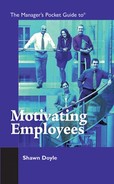The annual review is the second most important tool for employee motivation. The idea of an annual review has outlived its usefulness. A year is too long, and in today’s fast-paced world, an eternity. It is more effective to have a quick review each quarter, a six-month review, and a final year-end review. This gives the manager and employee more time for dialogue and course correction. I once had an annual review, and when the manager brought up something I had done, I couldn’t even remember having done it! The annual review should follow the same guidelines as the growth and development meeting. The key aspect of the annual review is it should be a formality summarizing what an employee and the manager already know. There should never be any surprises during an annual review. Every item on the review— both positive and negative—should have already been discussed during the year.
The review should be accompanied by information about the employee’s annual increase, which can be tremendously motivating. The manager should very carefully plan the wording of the increase in order to maximize the impact of the raise. Here is an example:
Let’s say an employee gets a 5 percent increase. Manager #1 says, “You have a 5 percent raise this year.” How motivating is that statement? Manager #2 says, “You know, Jill, you did a great job this year and you know the economy right now is tight. Most companies are giving increases in the 1 to 2 percent range. I hope you will be pleased with your increase, which is an outstanding 5 percent.” See the difference?
The challenge that many managers have is when the company they work for is giving out low raises to all employees. This is when the art of management comes into play. When raises are low, communicate clearly and honestly—don’t sugar coat it. Make sure they know that everyone had low raises. Ironically, there have been many, many studies that have shown that raises don’t motivate people, that conditions motivate people. The raise can get them excited, but the excitement wears off quickly.
The manager should also make sure that the team is involved in development opportunities as a team. This can be done in many ways:
• Team meetings. Training can be done at a team or staff meeting by an internal or external resource.
• Seminars. Take the entire team to a one-day seminar.
• Conferences. Take the team to an industry conference.
• Book group. Get a book for everyone to read and meet to discuss it.
• Field trips. Have the team visit something that is applicable to your business.
Employee motivation can be greatly shaped by a commitment to development. The ways in which a manager can develop their team is limited only by their imagination. Finally, there are many creative approaches to development that don’t have to cost a lot of money. The key point is that the managers make a commitment to the employees’ development, which is paramount for establishing an environment that is motivating.
